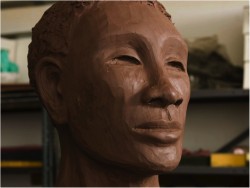Multimedia: York Memorial honors neglected historical figure
Open gallery

This spring, a new memorial appears on Lewis & Clark’s campus, honoring a key member of the Corps of Discovery too long ignored by history. Dedicated on May 8, 2010, York: Terra Incognita memorializes a man who served on the expedition as the slave of William Clark, who became a crucial contributor to the expedition’s success—and who, after the completion of the journey, shared in none of the fame and fortune enjoyed by other members of the corps.
The following video offers context about York’s historical significance and tells the story of how the memorial came to be at Lewis & Clark.
Located near Watzek Library, the York sculpture stands six feet tall and is mounted on an approximately two-foot bronze base with scattered text fragments embedded around it. Neither the physique nor facial features of the sculpture claim to represent what York actually looked like.
“Because there are no known images of York,” artist Alison Saar explains, “I felt a realistic portrait would only continue to misrepresent the man.”
Partly for this reason, Saar made the sculpture’s back a focal point and a symbol of the burden borne by York during the Lewis and Clark expedition. One of William Clark’s maps is inscribed—“scarred” might be more accurate—on the sculpture’s back and shoulders.
In her proposal to the York Committee, Saar wrote, “I have a personal interest in the recognition of unsung heroes, particularly those who have been overlooked due to their race or gender.” She has previously completed several sculptures addressing this theme.
By funding and commissioning this work by a nationally recognized artist, Lewis & Clark strives to welcome people from minority populations to our campus community and to join the ongoing work to recognize historical figures, like York, who contributed greatly to our country but without acknowledgment or reward.
“The sculpture stands as a visual metaphor for a historic moment that we must regard more thoughtfully if we are to understand American history,” says York Committee Chair Linda Tesner, director of the Ronna and Eric Hoffman Gallery of Contemporary Art.
Dedication event details–the public is welcome to attend:
Saturday, May 8, 2010 at 10 a.m.
At the statue site located on the lawn west of Aubrey R. Watzek Library
J.R. Howard Hall lobby in the event of rain
Learn more about the York Memorial Project:
- Information and resources about the memorial
- Text fragments featured on the base of the memorial, drawn from the journals of Lewis and Clark and other sources
- York Memorial Project history
- York Project Committee
More Newsroom Stories
Public Relations is located in McAfee on the Undergraduate Campus.
MSC: 19
email public@lclark.edu
voice 503-768-7970
Public Relations
Lewis & Clark
615 S. Palatine Hill Road MSC 19
Portland OR 97219

